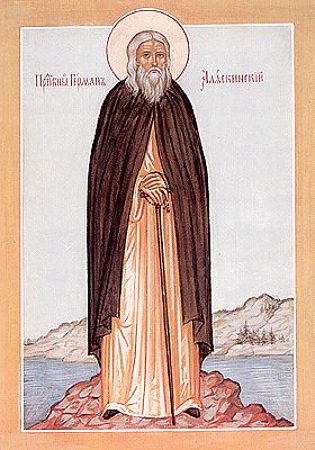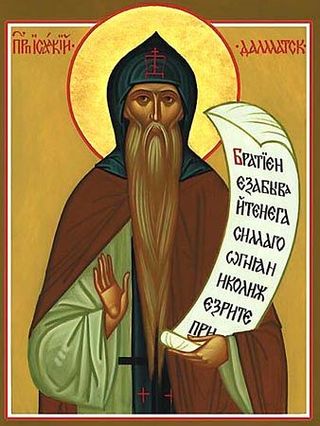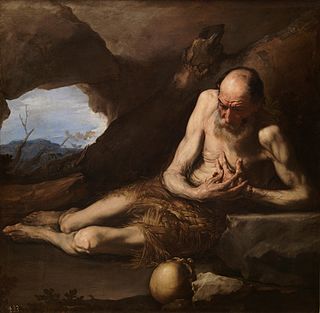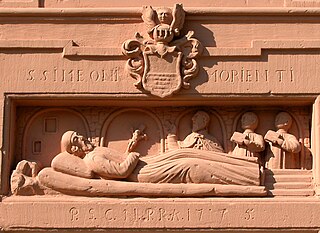Related Research Articles

Herman of Alaska was a Russian Orthodox monk and missionary to Alaska, which was then part of Russian America. His gentle approach and ascetic life earned him the love and respect of both the native Alaskans and the Russian colonists. He is considered by many Orthodox Christians to be the patron saint of North America.

The calendar of saints is the traditional Christian method of organizing a liturgical year by associating each day with one or more saints and referring to the day as the feast day or feast of said saint. The word "feast" in this context does not mean "a large meal, typically a celebratory one", but instead "an annual religious celebration, a day dedicated to a particular saint".

Onuphrius lived as a hermit in the desert of Upper Egypt in the 4th or 5th centuries. He is venerated as Saint Onuphrius in both the Roman Catholic and Eastern Catholic churches, as Venerable Onuphrius in Eastern Orthodoxy, and as Saint Nofer the Anchorite in Oriental Orthodoxy.

Saint Isaac the Confessor, also Isaacius or Isaakios, founder of the Dalmatian Monastery in Constantinople, was a Christian monk who is honored as a saint and confessor. He is sometimes referred to as Isaac the Dalmatian, not because he came from Dalmatia, but because of the monastery which he founded.

Sep. 12 - Eastern Orthodox liturgical calendar - Sep. 14

Apr. 30 - Eastern Orthodox Church calendar - May 2.

Paul of Thebes, commonly known as Paul the First Hermit or Paul the Anchorite, was an Egyptian saint regarded as the first Christian hermit and grazer, who was claimed to have lived alone in the desert of Thebes, Roman Egypt from the age of sixteen to the age of one hundred and thirteen years old. He was canonized in 491 by Pope Gelasius I, and is venerated as a saint by the Catholic Church, Eastern Orthodox Church, and Oriental Orthodox Churches.

Anthony of Kiev, also called Anthony of the Caves, was a monk and the founder of the monastic tradition in Kievan Rus'. Together with Theodosius of Kiev, he co-founded the Kiev Pechersk Lavra.

Nilus the Younger, also called Neilos of Rossano was a Griko monk and abbot from Calabria. He was the founder of Italo-Byzantine monasticism in southern Italy. He is venerated as a saint in the Eastern Orthodox and Catholic churches, and his feast day is celebrated on September 26 in both the Byzantine calendar and the Roman Martyrology.

Euphrosyne of Alexandria, also called Euphrosynē, was a saint who disguised herself as a male to enter a monastery and live, for 38 years, as an ascetic. Her feast day is celebrated on September 25 by the Greek Orthodox Church and Byzantine Rite Catholics, on September 27 by the Episcopal Church, and on January 16 by the Roman Catholic Church.

Pietro I Orseolo OSBCam, also known as Peter Urseulus, (928–987) was the Doge of Venice from 976 until 978. He abdicated his office and left in the middle of the night to become a monk. He later entered the order of the Camaldolese Hermits of Mount Corona. He is venerated as a saint in the Eastern Orthodox Church and Roman Catholic Church.

Sabas (439–532), in Church parlance Saint Sabas or Sabbas the Sanctified, was a Cappadocian Greek monk, priest, grazer and saint, who was born in Cappadocia and lived mainly in Palaestina Prima. He was the founder of several convents, most notably the one known as Mar Saba, in Palestine. The saint's name is derived from Imperial Aramaic: סַבָּא Sabbāʾ "old man".

Barsanuphius, also known as Barsanuphius of Palestine, Barsanuphius of Gaza or Barsanuphius the Great, was a Christian hermit and writer of the sixth century.

Bonfilius was an Italian saint, monk and bishop.

Leoluca, also Leone Luca, Leo Luke of Corleone, Saint Leoluca, or Luke of Sicily was the abbot and wonderworker of the monastery of Mount Mula in Calabria, and a founder of Italo-Greek monasticism in southern Italy. He is venerated as a saint in the Roman Catholic and Eastern Orthodox churches.

Saint Simeon of Trier, also written as Symeon, was a monk and recluse who died in Germany in 1035. He is venerated as a saint in the Eastern Orthodox Church with his feast day on 1 May, as well as in the Catholic Church, particularly in Germany.

August 28 - Eastern Orthodox liturgical calendar - August 30

August 29 - Eastern Orthodox liturgical calendar - August 31

Peter was an Italian Cistercian monk and prelate. He was the abbot of Rivalta from 1180 until 1185, abbot of Lucedio from 1185 until 1205, abbot of La Ferté from 1205 until 1206, bishop of Ivrea from 1206 until 1208 and patriarch of Antioch from 1209 until his death. He is known as Peter of Magnano, Peter of Lucedio or Peter of Ivrea.

John of Tufara also known as John the Hermit was an Italian hermit, monastery founder, and saint in the Catholic Church. He is the patron saint of his birth town Tufara and of Foiano di Val Fortore where he died.